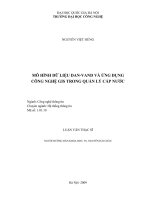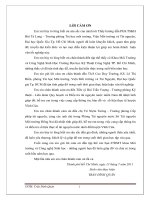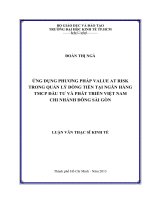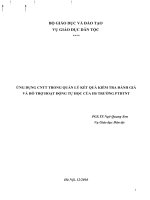Tìm hiểu về nhận dạng vân tay và khả năng ứng dụng trong quản lý cấp phát, kiểm soát hộ chiếu điện tử
Bạn đang xem bản rút gọn của tài liệu. Xem và tải ngay bản đầy đủ của tài liệu tại đây (1.12 MB, 58 trang )
Bộ giáo dục và đào tạo
tr-ờng đại học dân lập hải phòng
ISO 9001-2008
Khóa luận tốt nghiệp
ngành: NGOạI NGữ
Sinh viên : Đỗ Thị Nhung
Ng-ời h-ớng dẫn: Ths. Nguyễn Thị Thuý Thu
(Yêu cầu ghi đầy đủ học hàm, học vị )
Hải phòng - 2009
Haiphong private university
Department of foreign languages
Graduation paper
A study on euphemism used in expressing
the death in English and Vietnamese
By:
Đỗ Thị Nhung
Class:
NA904
Supervisor:
Nguyễn Thị Thuý Thu, M.A
Hai phong - 2009
Bộ giáo dục và đào tạo
tr-ờng đại học dân lập hải phòng
Nhiệm vụ đề tài tốt nghiệp
Sinh viên: Mã số:
Lớp: Ngnh
Tên đề tài:
Nhiệm vụ đề tài
1. Nội dung và các yêu cầu cần giải quyết trong nhiệm vụ đề tài tốt nghiệp
(Về lý luận, thực tiễn, các số liệu cn tớnh toỏn v cỏc bn v)
.
.
.
.
2. Cỏc ti liu, s liu cn thit thit k, tớnh toỏn
.
.
.
3. Địa điểm thực tập tốt nghiệp
.
.
Cán bộ h-ớng dẫn đề tài tốt nghiệp
Ng-ời h-ớng dẫn thứ nhất:
Họ và tên:
Học hàm, học vị:
Cơ quan công tác:
Nội dung h-ớng dẫn:
.
.
.
.
Ng-ời h-ớng dẫn thứ hai:
Họ và tên:
Học hàm, học vị:
Cơ quan công tác:
Nội dung h-ớng dẫn:
.
.
.
.
Đề tài tốt nghiệp đ-ợc giao ngày tháng năm 2009
Yêu cầu phải hoàn thành xong tr-ớc ngày tháng năm 2009
Đã nhận nhiệm vụ ĐTTN Đã giao nhiệm vụ ĐTTN
Sinh viên Ng-ời h-ớng dẫn
Hải Phòng, ngày tháng năm 2009
Hiệu tr-ởng
GS.TS.NGƯT Trần Hữu Nghị
Phần nhận xét tóm tắt của cán bộ h-ớng dẫn
1. Tinh thần thái độ của sinh viên trong quá trình làm đề tài tốt nghiệp:
2. Đánh giá chất l-ợng của khoỏ lun (So với nội dung yêu cầu đã đề ra
trong nhiệm vụ Đ.T. T.N trên các mặt lý luận, thực tiễn, tính toán số
liệu):
3. Cho điểm của cán bộ h-ớng dẫn (ghi cả số và chữ):
Hải Phòng, ngày tháng năm 2009
Cán bộ h-ớng dẫn
(Ký và ghi rõ họ tên)
Nhận xét đánh giá của ng-ời chấm phản biện
đề tài tốt nghiệp
1. Đánh giá chất l-ợng đề tài tốt nghiệp về các mặt thu thập và phân tích tài
liệu, số liệu ban đầu; giá trị lí luận và thực tiễn của đề tài.
2. Cho điểm của ng-ời chấm phản biện:
(im ghi bng s v ch)
Ngày tháng năm 2009
Ng-ời chấm phản biện
Acknowledgement
I would like to express my deep gratitude to my supervisor, Mrs. Nguyen Thi Thuy
Thu, for her patient and invaluable guidance at every stage of the study. To me, it is
fortunate to have her encouragement and critical comments throughout the study.
And I owe a special debt of gratitude to all teachers of the English department of
Hai Phong Private University for their lectures who has thoughtfully trained me in
the last four years.
My thanks also go to all of my friends and whose names are not identified here for
their assistance and advice.
Finally, I would like to thank every member of my family for their continuing
support and precious help to the completion of this study.
ABBREVIATIONs
P
PP
SOB
Sb
Ex
Part
Paper
Son of a bitch
Somebody
Example
Table of contents
Acknowledgement
List of abbreviations
Part one: Introduction 1
1. Rationale 1
2. Aims of the study 1
3. Scope of the study 2
4. Methods of the study 2
5. Design of the study 3
Part two: Development 4
Chapter 1: theoretical background 4
I. Definitions 4
1. What is Euphemism? 4
1.1. Some definitions of English Euphemism 4
1.2. Some example of English Euphemism 5
2. Classification of euphemisms 6
2.1. Terms of foreign and/or technical origin 6
2.2. Abbreviations 6
2.2.1. Abbreviations using a spelling alphabet 7
2.2.2. Plays on abbreviations 7
2.2.3. Use in mostly clinical settings 7
2.2.4. Abbreviations for phrases 7
2.3. Abstractions and ambiguities 7
2.4. Indirections 7
2.5. Mispronunciation 7
2.6. Slang 7
II. Characteristics of English Euphemism 7
1. Universality 8
2. Localization 8
3. Contemporaneity 8
4. Language Territory 8
5. National Characteristic 9
6. Having division of the sentimental color 9
7. Having life 9
8. Sociality 9
9. Re-symbolism 10
10. Arbitration 10
11. Relevance and Indirect 10
12. The English Euphemism of Idiom and Temporary 11
13. Fuzziness 11
14. Humorous 12
15. Accuracy 12
III The major function of the English Euphemism 12
1. The social communicative function of English euphemism 12
1.1. The evasive function of English euphemism 13
1.2. The polite function of English euphemism 14
1.3. The cosmetic function of English euphemism 14
2. The communication function of English Euphemism 16
2.1. Avoidance of taboo 16
2.2. Politeness 16
2.3. Avoidance of vulgarism 17
2.4. Covering up 17
Chapter 2: On English “Death” Euphemism 19
1. Understanding English “Death” Euphemism 19
1.1. Introduction 19
1.2. English “Death” Euphemism and Culture 20
1.3. The main origin of “Death” Euphemism 21
1.3.1. Christianity Belief 21
1.3.2. Funeral Way 22
1.3.3. Professional Language 23
1.4. The Development of “Death” Euphemism 24
2. Why Euphemism “Death” Euphemism? 25
2.1. English “death” Euphemism and Metaphor 25
2.2. English “Death” Euphemism and Age, Relationship 29
2.2.1. Age 29
2.2.2. Relationship 29
2.3. English “Death” Euphemism and before or after death, Dead Cause 30
2.3.1. Before or After Dead 30
2.3.2. Dead Cause 31
2.4. English “Death” Euphemism and Oral expression, Slang 31
2.4.1. Oral Expression 31
2.4.2. Slang 32
2.5. Summary 33
Chapter 3: English and Vietnamese “death” euphemism in
comparison 34
1. Some example about “Death” Euphemism in English and Vietnamese 34
1.1. “Death” Euphemism and Metaphor 34
1.2. “Death” Euphemism and Age 35
1.3. “Death” Euphemism and Relationship 35
1.4. “Death” Euphemism and before 36
1.5. “Death” Euphemism and after death, Dead cause 36
1.6. “Death” Euphemism and Oral expression 37
1.7. “Death” Euphemism and Slang 37
2. The Similarities in using “Death” Euphemism in English and
Vietnamese 38
3. The Difference in using “Death” Euphemism in English and
Vietnamese 40
3.1. In English 40
3.2. In Vietnamese 41
Part III: Conclusion 43
1. The summary 43
2. Suggestions for further study 43
References 44
PART ONE: Introduction
_____________________________________________________________
1. Rationale of the study
Language is a system of characters which came into being from men’s common
labor, being developed and enriched with the development of men. With the
development of our society, a fair number of words are labeled frivolous vulgar or
at least inconsiderate, and some kinds of language as forbidden, as different
religions, superstitious, believes, social customs and other reasons. Meanwhile,
there were some other languages which are used to take place. In communication,
for better maintaining social relationship and exchanging ideas, people have to
resort to a new different kind of language, which can make distasteful ideas seem
acceptable or even desirable. This type of language is defined as “Euphemism” in
linguistics. It’s considered as “polite words or expressions that you instead of a
more direct one to avoid shocking or upsetting someone”. Euphemism has been
always played an important role in English and especially, it is chiefly the key
point for man in daily communication. Hence, with the hope to help English
learners understand more deeply about using Euphemism, I decided to choose the
research titled: “A study on Euphemism expressing Death in English and
Vietnamese”.
2. Aims of the study
Euphemism is a cultural phenomenon as well as a linguistic concept, every
language has its own euphemism, so does English. It’s deeply rooted in social life
and has a great influence on social communications.
This study aims at:
- Pointing out theoretical background including the definition of Euphemism,
its characteristics, type of Euphemism, its feature, its function.
- Bringing about some useful knowledge about using Euphemism expressing
death in English and Vietnamese and the comparison between them.
- Offering preliminary further studies about the study.
- Giving understanding on English “Death” Euphemism.
- Finding out the differences and similarities in the way of using Death
Euphemism in English and Vietnamese.
3. Scope of the study
Due to the limitation of time and my own knowledge, this study focuses on giving:
- Understanding about English Euphemism and the Death Euphemism in
English.
- Making clearly the similarities and difference about Death Euphemism in
English and Vietnamese.
4. Methods of the study
- To distinguish similarities, and difference in using Death Euphemism
between two languages, comparison is the most effective method. The result of
comparison helps to make language learning and teaching easier. For that reason, I
choose the contrastive analysis method in my study.
- Besides, this study is carried out by gathering and analyzing the reference
materials, Internet researching which contains a huge, convenient scope of
information as well as my personal knowledge day by day I learn from my
teachers, books, internet and friends.
5. Design of the study
This study consists of three main parts:
Part1 is the “Introduction” which introduces Rationale, Aims of the study, Scope of
the study, Methods of the study and Design of the study.
Part 2 is the “Development” which is divided into three main chapters:
Chapter 1 is the “Theoretical background” providing the definition, the
characteristics, the feature and the function of the Euphemism.
Chapter 2 is the “The “Death “Euphemism in English”.
Chapter 3 is the “Comparison between the Similarities and Difference of
Euphemism in expression of death in English and Vietnamese.
Part 3 is the “Conclusion” which summarizes the main points of the study
Part two: DEVELOPMENT
____________________________________________________________
Chapter1
THEORETICAL BACKGROUND
I. Definition
1. What is Euphemism?
There are words in every language which people instinctively because they are
considered indecent, indelicate, rude, too direct or impolite. They are often
described in a round-about way, by using substitutes called Euphemism.
1.1. Some definitions of English Euphemism
There are some definitions of English Euphemism I want to mention below:
According to Collins Essential English Dictionary 2nd Edition ( 2006):
“A euphemism is a polite word or phrase, which is used to describe a controversial
or indiscreet activity. A euphemism is a substitute word, which is often more
politically correct. But, a euphemistic statement can also be funny, humorous, or
witty depending on the context of the statement”.
()
According to Neaman & Silver, 1983, pp. 1-2:
“Euphemisms are words we use to soften the reality of what we are communicating
to a given listener or reader. They are a universal feature of language usage; all
cultures typically use them to talk about things they find terrifying (e.g., war,
sickness, death) because, anthropologically, "to speak a name was to evoke the
divinity whose power then had to be confronted").
American scholar Rawson (1983, p. 1) states:
“Euphemisms are embedded so deeply in our language that few of us, even those
who pride themselves on being plainspoken, ever get through a day without using
them. Euphemisms are pervasive in our society. It is essential we know some basic
meanings of the word “euphemism”. The word “euphemism” comes from ancient
Greek. The prefix “eu” means well, easily; there are such words as “eulogize”,
“eugenics”. The root “pheme” means speech or saying, and thus euphemism
literally means to speak in a pleasant manner or with good words. A definition of
euphemism given by Oxford advanced learners’ dictionary of current English
(1989) is: “Example of the use of pleasant, mild or indirect words or phrases in
place of more accurate or direct one”. Generally speaking, words that are subtle,
indirect or nice are euphemisms.
Euphemism is defined in Longman Dictionary of Contemporary English(1978):
“The use of a pleasanter less direct name for something thought to be
unpleasant. The new Edition of the Oxford Concise Dictionary (1976) defines
euphemism as “Substitution of mild or vague or roundabout expression for harsh or
direct one; expression that substitute.”
Euphemism is to use a polite or vague word or phrase used to replace another word
or phrase that is thought of as too direct or rude.
1.2. Some examples about Euphemism in English
When you love someone, and you want to talk to her your love, instead of using
the direct sentence “ I love you”, you can say:
- You waken up my days.
- Things won’t be the same without you.
- You are the apple of my eyes.
- You make me feel light in the darkness.
(Nguyen Manh Hung, English lexicology, 2003: 82)
For workers “ dismissed” is:
- Dehired
- Surplused
- When a company has to reduce their staff, they say they have “workforce
adjustment”.
- When they transfer workers to another factory or production lines, they say
they have to apply “vocational relocation”.
2. Classification of Euphemism
Many euphemisms fall into one or more of these categories:
2.1. Terms of foreign and/or technical origin (derrière, copulation, perspire,
urinate, security breach, mired de Toro, prophylactic, feces occur, shiest)
2.2. Abbreviations (SOB for son of a bitch, BS for bullshit, TS for tough shit, SOL
for shit out of luck or PDQ for pretty damn(ed) quick, BFD for big fucking deal,
STFU or STHU for shut the fuck/hell up, RTFM for read the fucking manual)
2.2.1. Abbreviations using a spelling alphabet, especially in military contexts
(Charlie Foxtrot for "Cluster fuck", Whiskey Tango Foxtrot Oscar for "What the
fuck, over?”, Bravo Sierra for "bullshit" — See Military slang)
2.2.2. Plays on abbreviations (H-e-double hockey sticks for "hell", "a-double
snakes" or "a-double-dollar-signs" for "ass", Sugar Honey Iced Tea for "shit", bee
with an itch or witch with a capital B for "bitch", catch (or see) you next Tuesday
(or Thursday) for "cunt")
2.2.3. Use in mostly clinical settings (PITA for "pain in the ass" patient).
2.2.4. Abbreviations for phrases that are not otherwise common (PEBKAC for
"Problem Exists between Keyboard and Chair", ID Ten T Error or ID-10T Error for
"Idiot", TOBAS for "Take out Back and Shoot")
2.3. Abstractions and ambiguities (it for excrement, the situation for pregnancy,
going to the other side for death, do it or come together in reference a sexual act,
tired and emotional for drunkenness.)
2.4. Indirections (behind, unmentionables, privates, live together, go to the
bathroom, sleep together, sub-navel activities).
2.5. Mispronunciation (goldarnit, dadgummit, efing (fucking cunt), freak in, be-
atch, shoot — See minced oath).
Litotes or reserved understatement (not exactly thin for "fat", not completely
truthful for "lied", not unlike cheating for "an instance of cheating").
Changing nouns to modifiers (makes her look slutty for "is a slut", right-wing
element for "Right Wing").
2.6. Slang e.g.: pot for marijuana, laid for sex and so on.
There is some disagreement over whether certain terms are or are not euphemisms.
For example, sometime the phrase visually impaired is labeled as a politically
correct euphemism for blind. However, visual impairment can be a broader term,
including, for example, people who have partial sight in one eye, or even those with
uncorrected poor vision, a group that would be excluded by the word blind.
There are three antonyms of euphemism: dysphemism, cacophonies, and power
word. The first can be either offensive or merely humorously deprecating with the
second one generally used more often in the sense of something deliberately
offensive. The last is used mainly in arguments to make a point seem more correct.
II. Characteristics of English Euphemism
In every society there are many things or taboos cannot be spoken or mentioned
directly, thus, people use some substitutions to express. They are called
euphemism. Euphemism is deeply inserted in language, our daily life and work.
Along with unceasingly enhancement of social civilization, speaking skill and good
interpersonal relationship also more and more profoundly affect people's life;
however, in language more and more euphemisms will be produced. Therefore, it
has very important practice significance and practical significance to the
euphemism research. But only carefully research the characteristics of euphemism
can understand it more accurately, and use it properly.
1. Universality
Euphemizing generally exists in almost every nation all over the world, no
matter how civilized it is. And in every natural language, both large families of
languages and languages of minorities, using euphemism is a common
phenomenon. Because almost all cultures seem to have certain notions or things
that people try to avoid mentioning directly
2. Localization
The different regions have the differences naturally; the different customs, the
different history, the different culture, and these differences embody the
localization of language. Many euphemisms are related to the folklore, and its
localization is clearly. (Xing hua, 1998: 145)
3. Contemporaneity
Language emerged in the process of communication, and it was developed,
enriched and evolved continuously. In this process, in order to adjust to the specific
environment, people should create different euphemism words on certain things,
conduct and phenomenon and so on.
4. Language Territory
Words used in different places, or different sentences have different meanings.
Because the language must be in certain environment, in different language
environment or in the same language environment of different age, identity, status,
or educating level, euphemism expressions are also different. Therefore, when
euphemism is applied, we should pay attention to language environment, choosing
the different words of features in type of writing, to make sentence more correct,
more polite.
5. National Characteristic
A part euphemism words is general in most of national languages, but another part
has the strong national characteristics. In Western culture, asking others’ age,
income, marital status, religious belief and political tendencies are considered to be
infringement of privacy and discourteous behavior.
6. Having division of the sentimental color
Mentions approximately, euphemism some are lofty, some are affectionate and
some are the vulgar bodies. For example, in the expression of death "to die" in
meaning a series of euphemism words, a part has the lofty color; Like "to expire"
“to pay the debt of nature", "to sleep" and so on, but has another part for the
affectionate of spoken language, slang or vulgar body, like "to kick the buck ", “to
go west” (Tran Binh, 1996: 451).
7. Having life
Some euphemisms having once completed its social intercourse mission would not
be existence, but some then are given new life in the long-term usage, (its
meanings) are accepted broadly and inherit to take over down, becoming fixed
phrase language or direct expression synonym, and exist in vocabulary. Such as
euphemism of the expression of liquor teases: “Medline”, “high cap”, “eye-opener”
and so on; And also have some substitutions of trousers , “inexpressible”,
“unwhisperable”, “unspeakable”, “one-must-not-men”, “indescribable” and so on.
8. Sociality
The language is a kind of social phenomenon; the different society could not exert
a same expression method. Even if in identical society's different social class,
social stratum, even different profession in the identical social class, the social
stratum as well as the quantity of people under different culture background using
the euphemism should be also different. For example the word “dead”, in each
society, in each culture has the different expression methods. According to
concerned scholars statistics, in Chinese the expression of “dead” reaches more
than 300, according to the incomplete statistics, in English it probably has more
than 230. If in consideration of those tactful parlance of temporary, its amount
would be far over this data. Like person believing in Marxist will speak "to see a
Marx". Person believing in Christianity will say "be with God”.
9. Re-symbolism
From the definition of euphemism, we can know clearly that euphemism is using
one expression to replace another. “That is to say, euphemism is a re-symbolizing
of things, ideas, or events already symbolized with precision in mind. Therefore
people can’t randomly utilize an expression to euphemize the taboos. The re-
symbolizing should provide clues to catch the intended meaning of the taboos and
should sound indirect or pleasanter”. Hence, euphemism is a kind of substitution in
fact; it is a manifestation of re-symbolism.
10. Arbitration
Euphemisms come from daily life, and most of them come from ordinary people.
Thus, arbitration is one of the most important characteristics of modern
euphemism. Once a man was interviewed on a farm on the west of Canada, he
called bull “he call” and “gentleman cow”. He used euphemism very optional.
11. Relevance and Indirect
Don't need to dispute, this is the biggest characteristics of euphemism. Using
euphemism just use its underlying way to express and avoid mentioning things or
phenomenon directly which may make people unpleasant. It is the essence of
euphemism. Therefore, indirect is one of euphemism main characteristics.
Relevance is that euphemism must enable the human to be associates with what it
mentions. Euphemism is a substitution of taboo, but it could not substitute things
freely. It substitute when is necessary and connection with the taboo. It is called
relevance. This manifested the euphemism to avoid awkward case which is caused
by people speaking without reservation. This is just the reason that euphemism
enjoys the favor
12. The English Euphemism of Idiom and Temporary
Many euphemisms in people's long time's use, have become the fixed expression,
already become idiom, and entered English glossary. Some euphemisms are
temporary. Some identical meaning's content uses the different euphemisms to
substitute in different unceasingly. Such as, mad which is instead by crazy, insane,
lunatic, mentally deranged and so on.
13. Fuzziness
Fuzziness is a basic feature of euphemism. In order to avoid mentioning some
notions, things or taboos directly, people always use semantic obscurity to take
place of the precise words. The euphemism fuzziness could conceal the brutal
reality. There are some examples. We do not say “blind” but say “visual retarded,
sight-deprived”; we do not say “be old”, but say “meet with the second childhood;
reach one’s golden age”; and we do not say “idiot”, but say “totally dependent”. To
avoid mentioning the term death, people take pains to substitute it with the terms of
pass away, be with God, go to a better world, etc. Moreover, when refers to disease,
to avoid vulgarly, the people conceal the truth with the fuzzy words and
expressions. For example, some diseases which cure with difficulties, such as
pulmonary tuberculosis before the 1950s and the cancer of contemporary and
AIDS, they are incurable illnesses which make people fear deeply. Once suffers,
people just liked being sentenced to death. Therefore, massive euphemism words
related to illness are formed in English. Like “falls ill” (be out of sorts), “scarlet”
(fever), “disease” (disorder), “stroke” (accident), “disgusting”, (stomach
awareness), “vomit” (lose a meal), “diarrhea” (Mexican toothache), “pulmonary
tuberculosis” (breast complaint), “syphilis” (bad blood), “gonorrhea” (hat and cap),
and “AIDS” (social disease ),and so on.(2000:27)
Therefore, if there is no fuzziness euphemism will lose its euphemistic value.
14. Humorous
In communication, humor is one kind perfect way to please others. The
euphemistic expression is always likely more pleasant than the direct expression,
others also easy to accept. Because it can manifest the humorous effect, the
humorous euphemism can help the people facing the reality with ease. People use
“push up daisies” to substitute “be buried” so as to ease people’s fear of death.
People changing “be sent into prison” into “live at government’s expenses”, can be
obviously reduce one’s pressure.
15. Accuracy
Stemming from human communication’s need, people do not state the matter
directly, but uses the relatively tactful express —the usage of euphemism, thus, an
identical matter has the different expression methods. When using different
expression methods should be according to the different linguistic environment, the
goal and the request, each expression in the specific linguistic environment is most
accurate. For example, there is many words means “to die”, such as “go depart”,
“decease”, “pass away”, “breathe one’s debt to nature”, “be in heaven”, “be with
God” and so on. In the daily life, people are often not willing to say some kind of
misfortune, particularly “the death", so usually change to express with euphemism.
The expression concerning about the die which enumerates up above compare to
say "die" directly to be more tactful, and make the person accept the fact of this
misery easily.
III. The major functions of English Euphemism
There are many functions of English euphemism, such as social function,
communicative function.
1. The social function of English euphemism
From the perspective of language communication, euphemism functions to avoid
taboos, to show politeness and conceal feelings. Thanks to euphemism, it is easy
for people to accept the things that are likely to make others feel embarrassed or
unhappy. It is people’s general character to express their ideas as mildly and
tactfully as possible. Euphemism helps people to reach this goal. From the moment









